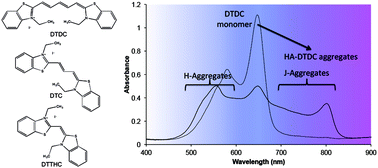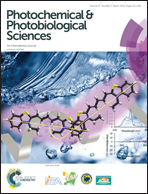Specific excitonic interactions in the aggregates of hyaluronic acid and cyanine dyes with different lengths of methine group†
Abstract
The absorption and circular dichroism (CD) spectra of three types of cyanine dyes with different lengths of methine group (3,3′-diethylthiadicarbocyanine iodide, DTDC; 3,3′-diethylthiacarbocyanine iodide, DTC; and 3,3′-diethylthiacyanine iodide, DTTHC) in an aqueous solution were compared with and without hyaluronic acid (HA), which has a helical structure. DTDC forms chiral H- and J-aggregates, whereas DTC and DTTHC are unable to form any aggregates. DTDC also forms H- and J-aggregates in the presence of sodium polyacrylate (PA) with a random-coil structure; however, the PA-DTDC aggregates exhibit no chirality. These results suggest that the chirality of HA-DTDC aggregates is induced by the helical structure of HA. In 2.4 vol% and 10 vol% methanol, HA-DTDC aggregates displayed different patterns of temperature dependence, whereas no aggregation was observed in 30 vol% methanol. The solubility of DTDC in a mixed solvent of water and methanol is generally improved by the addition of methanol, which prevents the aggregation of DTDC.


 Please wait while we load your content...
Please wait while we load your content...